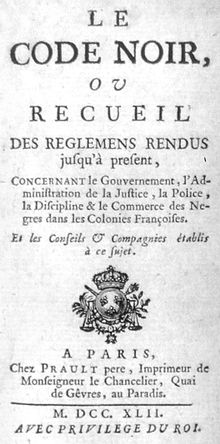
| Part of a series on |
| Forced labour and slavery |
|---|
 |
| Part of a series of articles on |
| Racial and ethnic segregation |
|---|
 |
The Code noir (French pronunciation: [kɔd nwaʁ], Black code) was a decree passed by King Louis XIV of France in 1685 defining the conditions of slavery in the French colonial empire and served as the code for slavery conduct in the French colonies up until 1789 the year marking the beginning of the French Revolution. The decree restricted the activities of free people of color, mandated conversion to Catholicism for all enslaved people throughout the empire, defined the punishments meted out to them, and ordered the expulsion of all Jewish people from France's colonies.
The code's effects on the enslaved population of the French colonial empire were complex and multifaceted. It outlawed the worst punishments owners could inflict upon their slaves, and led to an increase in the free population. Despite this, enslaved persons were still subject to harsh treatment at the hands of their owners, and the expulsion of Jews was an extension of antisemitic trends in the Kingdom of France.
Free people of color were still placed under restrictions via the Code noir, but were otherwise free to pursue their own careers. Compared to other European colonies in the Americas, a free person of color in the French colonial empire was highly likely to be literate, and had a high chance of owning businesses, properties and even their own slaves.[1][2][3] The code has been described by historian of modern France Tyler Stovall as "one of the most extensive official documents on race, slavery, and freedom ever drawn up in Europe".[4]
- ^ Stark, Rodney (2003). For the Glory of God: How Monotheism Led to Reformations, Science, Witch-Hunts, and the End of Slavery. Princeton University Press. p. 322. doi:10.2307/j.ctt1287k58. ISBN 978-1-4008-6680-9. JSTOR j.ctt1287k58.
- ^ Samantha Cook,Sarah Hull, "The Rough Guide to the USA"
- ^ Terry L. Jones, "The Louisiana Journey", p.115
- ^ Stovall, p. 205.